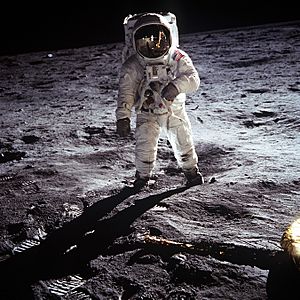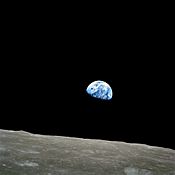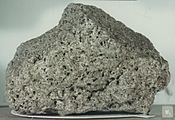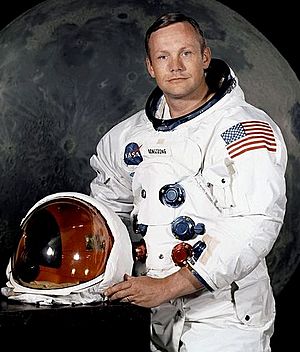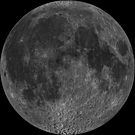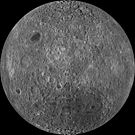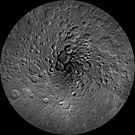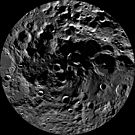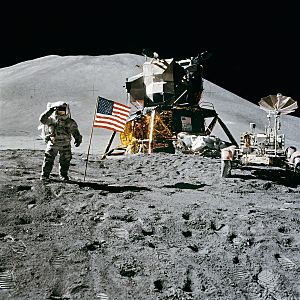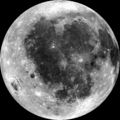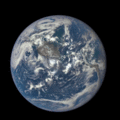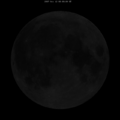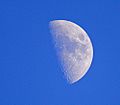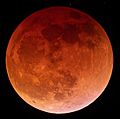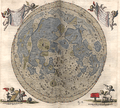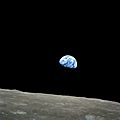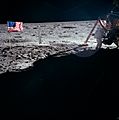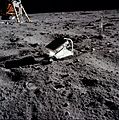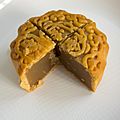Moon facts for kids
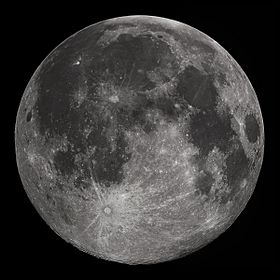
|
|||||||||||||
| Designations | |||||||||||||
|---|---|---|---|---|---|---|---|---|---|---|---|---|---|
| Adjectives | lunar, selenic | ||||||||||||
| Orbital characteristics | |||||||||||||
| Perigee | 363,104 km (0.002 4 AU) | ||||||||||||
| Apogee | 405,696 km (0.002 7 AU) | ||||||||||||
| 384,399 km (0.002 57 AU) | |||||||||||||
| Eccentricity | 0.054 9 | ||||||||||||
| 27.321 582 d (27 d 7 h 43.1 min) | |||||||||||||
| 29.530 589 d (29 d 12 h 44 min 2.9 s) | |||||||||||||
|
Average orbital speed
|
1.022 km/s | ||||||||||||
| Inclination | 5.145° to the ecliptic (between 18.29° and 28.58° to Earth's equator) |
||||||||||||
| regressing by one revolution in 18.6 years | |||||||||||||
| progressing by one revolution in 8.85 years | |||||||||||||
| Satellite of | Earth | ||||||||||||
| Physical characteristics | |||||||||||||
|
Mean radius
|
1,737.10 km (0.273 Earths) | ||||||||||||
| Flattening | 0.001 25 | ||||||||||||
| Circumference | 10,921 km (equatorial) | ||||||||||||
| 3.793 × 107 km² (0.074 Earths) | |||||||||||||
| Volume | 2.195 8 × 1010 km³ (0.020 Earths) | ||||||||||||
| Mass | 7.347 7 × 1022 kg (0.012 3 Earths) | ||||||||||||
|
Mean density
|
3,346.4 kg/m³ | ||||||||||||
| 1.622 m/s² (0.165 4 g) | |||||||||||||
| 2.38 km/s | |||||||||||||
|
Sidereal rotation period
|
27.321 582 d (synchronous) | ||||||||||||
|
Equatorial rotation velocity
|
4.627 m/s | ||||||||||||
| 1.542 4° (to ecliptic) 6.687° (to orbit plane) |
|||||||||||||
| Albedo | 0.12 | ||||||||||||
|
|||||||||||||
| −2.5 to −12.9 −12.74 (mean full moon) |
|||||||||||||
| 29.3 to 34.1 arcminutes | |||||||||||||
|
Surface pressure
|
2.25 × 10-12 torr | ||||||||||||
The Moon is Earth's natural satellite. We can usually see it shining brightly in the night sky. Many other planets also have their own moons. Scientists believe our Moon formed about 4.51 billion years ago, not long after Earth itself. The most popular idea is that the Moon was made from pieces left over after a huge crash. This crash happened between Earth and a Mars-sized object called Theia.
The Moon is about 3,500 kilometres (2,200 mi) wide. This is a bit more than a quarter of Earth's size. Earth is about 12,600 kilometres (7,800 mi) wide. Because of their similar sizes, Earth and the Moon are sometimes called a "double planet" system.
Contents
How the Moon Changes Shape: Phases
The Moon is round, and half of it is always lit by the Sun. As the Moon travels around (or orbits) the Earth, we see different amounts of its sunlit side. Sometimes, the entire side we see is bright. Other times, only a small part is lit. This happens because the Moon does not make its own light. We only see the parts that are lit up by sunlight. These different appearances are called the Phases of the Moon.
It takes the Moon about 29.53 days to complete one full cycle of phases. This is about 29 days, 12 hours, and 44 minutes. The cycle goes from a big, bright full moon to a small, dim new moon, and back again. When the Moon passes between Earth and the Sun, it's called a new moon. We can't see it then. After that, it becomes a "waxing crescent", then "first quarter", "waxing gibbous", and finally a "full moon". A full Moon happens when the Moon and Sun are on opposite sides of Earth. As the Moon continues its journey, it becomes a "waning gibbous", "third quarter", and "waning crescent". Then it returns to a new moon. People used the Moon to measure time. A month is roughly the same length as one lunar cycle.
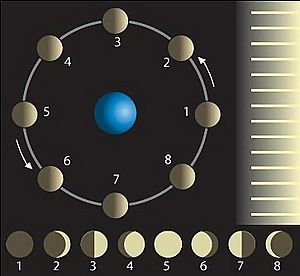
The Moon always shows the same side to Earth. Astronomers call this tidal locking. This means that one half of the Moon can never be seen from Earth. The side facing away from Earth is called the far side. It's sometimes called the dark side of the Moon, but the Sun does shine on it. We just never see it lit from Earth.
Exploring the Moon: A Journey Through Time
Before humans walked on the Moon, the United States and the Soviet Union sent robots there. These robots would orbit the Moon or land on its surface. They were the first human-made objects to touch the Moon.
Humans finally landed on the Moon on July 21, 1969. Astronauts Neil Armstrong and Buzz Aldrin landed their lunar ship, called the Eagle, on the Moon's surface. Half the world watched on television as Armstrong climbed down the ladder. He was the first human to touch the Moon. He famously said, "That's one small step for a man, one giant leap for mankind."
Even though their footprints were left on the Moon a long time ago, they are probably still there. The Moon has no wind or rain, so erosion (wearing away) happens very slowly. The footprints don't get filled in or smoothed out.
More people landed on the Moon between 1969 and 1972. The last spaceship to visit was Apollo 17. Eugene Cernan of Apollo 17 was the last person to touch the Moon.
United States Missions to the Moon
In 1961, President John F. Kennedy promised that the United States would land a person on the Moon before the end of the decade. To prepare for this, NASA sent many unmanned probes to the Moon. These probes helped scientists understand the lunar surface.
The Apollo program was developed at the same time. After many tests of the Apollo spacecraft, Apollo 8 made the first manned mission to lunar orbit in 1968. This was a big step in the Space Race. The landing of the first humans on the Moon in 1969 is seen as a major achievement.
Neil Armstrong became the first person to walk on the Moon. He was the commander of the American mission Apollo 11. He stepped onto the Moon at 02:56 UTC on July 21, 1969. About 500 million people around the world watched this live broadcast on television. It was the largest television audience at that time.
The Apollo missions (11 to 17, except Apollo 13) brought back a lot of Moon rocks and soil. They collected about 380.05 kilograms (837.87 lb) of samples. These samples were in 2,196 separate pieces. The success of the American Moon landing was possible because of many new technologies. These included advances in materials, software engineering, and how spacecraft re-enter Earth's atmosphere.
Scientists also left special equipment on the Moon during the Apollo landings. These included heat probes, seismometers (to detect moonquakes), and magnetometers (to measure magnetic fields). These instruments sent data back to Earth until 1977.
Other Countries Explore the Moon
After the first Moon race, there were many years of quiet. But starting in the 1990s, more countries began exploring the Moon. In 1990, Japan became the third country to send a spacecraft into lunar orbit. This was their Hiten spacecraft.
In 1994, the U.S. sent the Clementine spacecraft to orbit the Moon. This mission created the first detailed map of the Moon's surface. It also took the first global images showing different materials on the Moon. In 1998, the Lunar Prospector mission followed. Its instruments found signs of hydrogen at the Moon's poles. This likely means there is water ice hidden in shadowed craters.
India, Japan, China, the United States, and the European Space Agency have all sent spacecraft to orbit the Moon. India's Chandrayaan-1 helped confirm the discovery of water ice in permanently shadowed craters. It also found water bound into the lunar soil.
The European spacecraft SMART-1 orbited the Moon from 2004 to 2006. It used a special ion engine. It made the first detailed survey of chemical elements on the Moon's surface.
After the Apollo era, there have also been two rover missions. The last Soviet Lunokhod mission was in 1973. China's Chang'e 3 mission landed its Yutu rover in 2013. China plans to launch another rover mission, Chang'e 4, before 2020. The Moon remains open for all nations to explore peacefully. This is stated in the Outer Space Treaty.
In 2018, several companies announced plans to install a 4G wireless network on the Moon. The goal is to stream live video from the Moon's surface to Earth.
What the Moon is Like
Because it is smaller, the Moon has less gravity than Earth. It has only about 1/6 of Earth's gravity. So, if a person weighs 120 kg on Earth, they would only weigh 20 kg on the Moon. Even though the Moon's gravity is weaker, it is still there. If you dropped a ball on the Moon, it would still fall down. However, it would fall much more slowly. If you jumped as high as you could on the Moon, you would jump higher than on Earth. But you would still fall back to the ground.
The Moon has no atmosphere (a layer of air). This means there is no air resistance. So, a feather will fall just as fast as a hammer on the Moon.
Without an atmosphere, the Moon's environment is not protected from extreme heat or cold. Astronauts wore special spacesuits. These suits protected them and carried oxygen for them to breathe. The suit weighed about as much as the astronaut. But because the Moon's gravity is weak, the suit didn't feel as heavy as it would on Earth.
On Earth, the sky looks blue. This is because blue rays of sunlight bounce off the gases in our atmosphere. This makes it look like blue light is coming from the sky. But on the Moon, there is no atmosphere. So, the sky looks black, even during the daytime.
Because there is no atmosphere, the Moon is not protected from rocks falling from outer space. These meteorites crash right into the Moon. They make wide, shallow holes called craters. The Moon has thousands of them. Newer craters slowly wear away the older ones.
A blue moon is an extra full moon that appears in a certain time period. It can be the third of four full moons in a season. Or it can be the second full moon in a single month on our calendar.
How the Moon Was Formed
The giant impact hypothesis is the leading scientific idea for how the Moon formed. It suggests that the Moon was created from the pieces left over after a huge crash. This collision happened between the young Earth and a Mars-sized early planet.
Water on the Moon
In 2009, NASA announced they had found a lot of water on the Moon. This water is not liquid. It is in the form of hydrates and hydroxides. Liquid water cannot exist on the Moon. This is because sunlight quickly breaks down the water molecules. However, images from NASA show that water has existed on the Moon in the past.
Who Owns the Moon?
Even though Soviet spacecraft left flags on the Moon, and U.S. flags were planted by the Apollo astronauts, no country owns any part of the Moon's surface. Russia, China, and the U.S. all signed the 1967 Outer Space Treaty. This treaty says that the Moon and all of outer space belong to "all mankind".
This treaty also says that the Moon can only be used for peaceful purposes. It specifically bans military bases and weapons of mass destruction. The 1979 Moon Agreement was made to stop any single nation from taking the Moon's resources. However, as of November 2016, only 18 nations have signed it. None of these nations are currently sending humans into space or planning to. Some people have tried to claim parts of the Moon for themselves, but these claims are not considered real.
Related pages
Images for kids
-
Lunar crater Daedalus on the Moon's far side.
-
The geologic map of the Moon by Chinese Academy of Sciences.
-
Libration, the slight change in the Moon's apparent size and viewing angle from Earth.
-
The Moon, tinted reddish, during a lunar eclipse.
-
Galileo's sketches of the Moon from his book Sidereus Nuncius.
-
Map of the Moon by Johannes Hevelius from his Selenographia (1647).
-
A replica of Lunokhod 1, the first remote controlled rover on another planet (1970).
-
Neil Armstrong, the first human on the Moon, working at the Lunar Module Eagle, during Apollo 11 (1969).
-
One of the first moon rocks (Lunar basalt 70017, Apollo 17, 1972).
-
NASA's Moon Mineralogy Mapper on India's Chandrayaan-1 discovered water-rich minerals (light blue) in 2008.
-
A photo of the reflector of the Lunar Laser Ranging Experiment of Apollo 11, still in use.
-
A Mooncake, given at the Harvest Moon Festival, a celebration in the Chinese Lunar Calendar.
-
Scale model of the Earth–Moon system: Sizes and distances are to scale.
See also
 In Spanish: Luna para niños
In Spanish: Luna para niños


